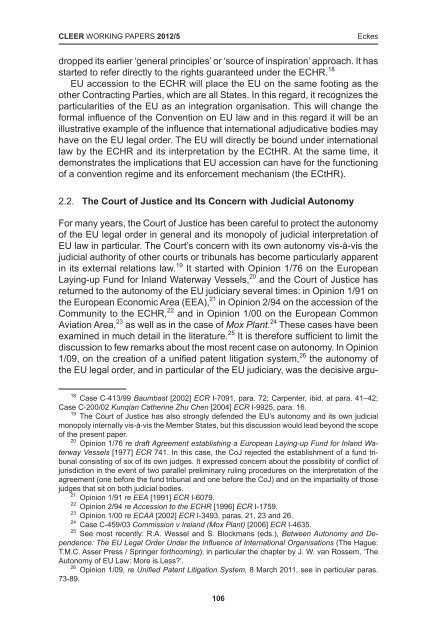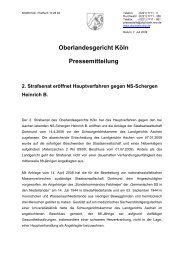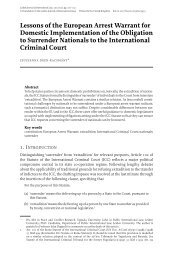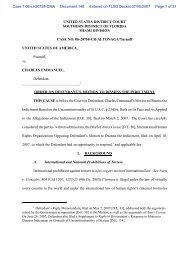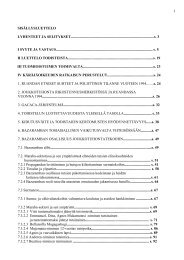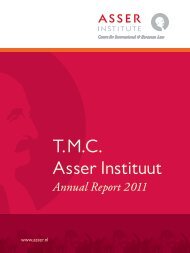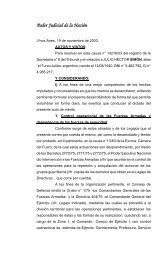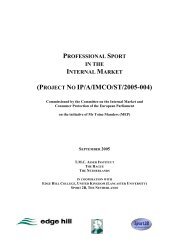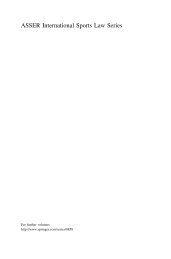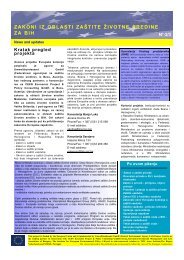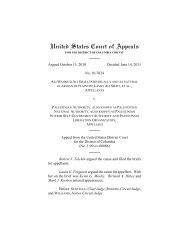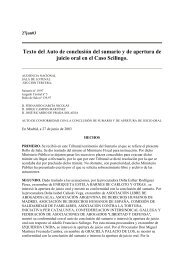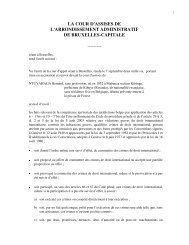Principles and practices of EU external representation - TMC Asser ...
Principles and practices of EU external representation - TMC Asser ...
Principles and practices of EU external representation - TMC Asser ...
Create successful ePaper yourself
Turn your PDF publications into a flip-book with our unique Google optimized e-Paper software.
CLEER WORKING PAPERS 2012/5<br />
Eckes<br />
dropped its earlier ‘general principles’ or ‘source <strong>of</strong> inspiration’ approach. It has<br />
started to refer directly to the rights guaranteed under the ECHR. 18<br />
<strong>EU</strong> accession to the ECHR will place the <strong>EU</strong> on the same footing as the<br />
other Contracting Parties, which are all States. In this regard, it recognizes the<br />
particularities <strong>of</strong> the <strong>EU</strong> as an integration organisation. This will change the<br />
formal influence <strong>of</strong> the Convention on <strong>EU</strong> law <strong>and</strong> in this regard it will be an<br />
illustrative example <strong>of</strong> the influence that international adjudicative bodies may<br />
have on the <strong>EU</strong> legal order. The <strong>EU</strong> will directly be bound under international<br />
law by the ECHR <strong>and</strong> its interpretation by the ECtHR. At the same time, it<br />
demonstrates the implications that <strong>EU</strong> accession can have for the functioning<br />
<strong>of</strong> a convention regime <strong>and</strong> its enforcement mechanism (the ECtHR).<br />
2.2. The Court <strong>of</strong> Justice <strong>and</strong> Its Concern with Judicial Autonomy<br />
For many years, the Court <strong>of</strong> Justice has been careful to protect the autonomy<br />
<strong>of</strong> the <strong>EU</strong> legal order in general <strong>and</strong> its monopoly <strong>of</strong> judicial interpretation <strong>of</strong><br />
<strong>EU</strong> law in particular. The Court’s concern with its own autonomy vis-à-vis the<br />
judicial authority <strong>of</strong> other courts or tribunals has become particularly apparent<br />
in its <strong>external</strong> relations law. 19 It started with Opinion 1/76 on the European<br />
Laying-up Fund for Inl<strong>and</strong> Waterway Vessels, 20 <strong>and</strong> the Court <strong>of</strong> Justice has<br />
returned to the autonomy <strong>of</strong> the <strong>EU</strong> judiciary several times: in Opinion 1/91 on<br />
the European Economic Area (EEA), 21 in Opinion 2/94 on the accession <strong>of</strong> the<br />
Community to the ECHR, 22 <strong>and</strong> in Opinion 1/00 on the European Common<br />
Aviation Area, 23 as well as in the case <strong>of</strong> Mox Plant. 24 These cases have been<br />
examined in much detail in the literature. 25 It is therefore sufficient to limit the<br />
discussion to few remarks about the most recent case on autonomy. In Opinion<br />
1/09, on the creation <strong>of</strong> a unified patent litigation system, 26 the autonomy <strong>of</strong><br />
the <strong>EU</strong> legal order, <strong>and</strong> in particular <strong>of</strong> the <strong>EU</strong> judiciary, was the decisive argu-<br />
18 Case C-413/99 Baumbast [2002] ECR I-7091, para. 72; Carpenter, ibid. at para. 41–42;<br />
Case C-200/02 Kunqian Catherine Zhu Chen [2004] ECR I-9925, para. 16.<br />
19 The Court <strong>of</strong> Justice has also strongly defended the <strong>EU</strong>’s autonomy <strong>and</strong> its own judicial<br />
monopoly internally vis-à-vis the Member States, but this discussion would lead beyond the scope<br />
<strong>of</strong> the present paper.<br />
20 Opinion 1/76 re draft Agreement establishing a European Laying-up Fund for Inl<strong>and</strong> Waterway<br />
Vessels [1977] ECR 741. In this case, the CoJ rejected the establishment <strong>of</strong> a fund tribunal<br />
consisting <strong>of</strong> six <strong>of</strong> its own judges. It expressed concern about the possibility <strong>of</strong> conflict <strong>of</strong><br />
jurisdiction in the event <strong>of</strong> two parallel preliminary ruling procedures on the interpretation <strong>of</strong> the<br />
agreement (one before the fund tribunal <strong>and</strong> one before the CoJ) <strong>and</strong> on the impartiality <strong>of</strong> those<br />
judges that sit on both judicial bodies.<br />
21 Opinion 1/91 re EEA [1991] ECR I-6079.<br />
22 Opinion 2/94 re Accession to the ECHR [1996] ECR I-1759.<br />
23 Opinion 1/00 re ECAA [2002] ECR I-3493, paras. 21, 23 <strong>and</strong> 26.<br />
24 Case C-459/03 Commission v Irel<strong>and</strong> (Mox Plant) [2006] ECR I-4635.<br />
25 See most recently: R.A. Wessel <strong>and</strong> S. Blockmans (eds.), Between Autonomy <strong>and</strong> Dependence:<br />
The <strong>EU</strong> Legal Order Under the Influence <strong>of</strong> International Organisations (The Hague:<br />
T.M.C. <strong>Asser</strong> Press / Springer forthcoming); in particular the chapter by J. W. van Rossem, ‘The<br />
Autonomy <strong>of</strong> <strong>EU</strong> Law: More is Less?’.<br />
26 Opinion 1/09, re Unified Patent Litigation System, 8 March 2011, see in particular paras.<br />
73-89.<br />
106


